find()
The find() method in JavaScript is used to search an array for an element that satisfies a condition specified by a callback function. It returns the value of the first element in the array that satisfies the condition, or undefined if no such element is found.
The syntax for the find() method is as follows:

Here, array is the array to search, callback is the function that defines the condition to be tested, and thisArg is an optional parameter that specifies the value of this to be used when executing the callback function. If thisArg is not specified, undefined is used as the value of this.
The callback function is called on each element of the array until an element that satisfies the condition is found. The function takes three parameters: the value of the current element, the index of the current element, and the array being traversed. The function should return true if the element satisfies the condition, or false otherwise.
Here is an example of using the find() method to search an array for an element that satisfies a condition:

In this example, the find() method is called on the numbers array with a callback function that tests whether a number is even. The method returns the value 2, which is the first even number in the array.
If no element in the array satisfies the condition, the method returns undefined. Here’s an example:

In this example, the find() method is called on the numbers array with a callback function that tests whether a number is even. Since there are no even numbers in the array, the method returns undefined.
The find() method is useful for searching an array for an element that satisfies a condition, such as finding a specific object in an array of objects based on a property value. It can also be used in conjunction with other array methods, such as filter() and map(), to perform more complex operations on an array.
findIndex()
The findIndex() method in JavaScript is similar to the find() method, but it returns the index of the first element in an array that satisfies a condition specified by a callback function. If no element satisfies the condition, the method returns -1.
The syntax for the findIndex() method is as follows:

Here, array is the array to search, callback is the function that defines the condition to be tested, and thisArg is an optional parameter that specifies the value of this to be used when executing the callback function. If thisArg is not specified, undefined is used as the value of this.
The callback function is called on each element of the array until an element that satisfies the condition is found. The function takes three parameters: the value of the current element, the index of the current element, and the array being traversed. The function should return true if the element satisfies the condition, or false otherwise.
Here is an example of using the findIndex() method to search an array for the index of an element that satisfies a condition:

In this example, the findIndex() method is called on the numbers array with a callback function that tests whether a number is even. The method returns the value 1, which is the index of the first even number in the array.
If no element in the array satisfies the condition, the method returns -1. Here’s an example:

In this example, the findIndex() method is called on the numbers array with a callback function that tests whether a number is even. Since there are no even numbers in the array, the method returns -1.
The findIndex() method is useful for finding the index of an element that satisfies a condition, such as finding the index of a specific object in an array of objects based on a property value. It can also be used in conjunction with other array methods, such as filter() and map(), to perform more complex operations on an array.
includes()
The includes() method in JavaScript is a handy way to check whether an array contains a specific element or not. The method returns a boolean value indicating whether the element is found or not.
Here’s the syntax for the includes() method:

The array parameter is the array on which to perform the search. The element parameter is the value to search for in the array. The start parameter is optional and specifies the index from which to start the search. If not provided, the default value is 0.
The includes() method searches the array for the specified element, starting at the index specified by the start parameter. If the element is found, the method returns true; otherwise, it returns false.
Here’s an example of using the includes() method:

In this example, the includes() method is called on the numbers array to check whether the value 3 is present in the array. Since 3 is present in the array, the method returns true.If the element is not found in the array, the method returns false. Here’s an example:

In this example, the includes() method is called on the numbers array to check whether the value 6 is present in the array. Since 6 is not present in the array, the method returns false.
The includes() method is a useful way to check for the presence of an element in an array without having to write a loop or use other array methods like indexOf(). It can also be used in combination with other array methods to perform more complex operations on an array.
entries()
The entries() method in JavaScript is a built-in array method that returns an iterable object containing the key-value pairs for each index in the array. The key in each pair is the index of the element, and the value is the corresponding element at that index. The entries() method returns the iterable object, which can be used in a for loop or with the spread operator to access the key-value pairs.
Here’s the syntax for the entries() method:

The array parameter is the array on which to perform the operation.
Here’s an example of using the entries() method:
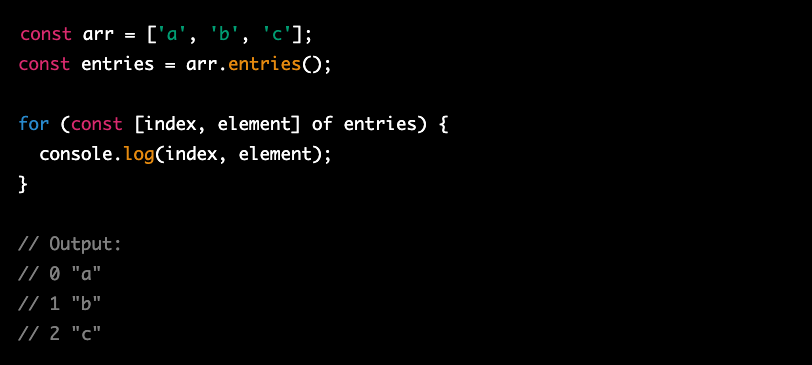
In this example, the entries() method is called on the arr array to get the key-value pairs for each index in the array. The returned iterable object is then used in a for loop to access each key-value pair. The of operator is used to destructure the key-value pairs into separate variables index and element, which are then logged to the console.
The entries() method can also be used with the spread operator to create a new array of key-value pairs:

In this example, the entries() method is called on the arr array, and the resulting iterable object is spread into a new array of key-value pairs. The resulting array contains subarrays, each with an index and its corresponding element in the original array.
The entries() method is a powerful tool for working with arrays, as it allows you to easily access the key-value pairs for each index in the array.
every()
The every() method in JavaScript is a built-in array method that tests whether all elements in the array pass a certain condition. The every() method returns a Boolean value of true if all elements in the array pass the condition, and false otherwise.
Here’s the syntax for the every() method:

The array parameter is the array on which to perform the operation. The callback function is the function to execute on each element in the array. The callback function takes three arguments: element (the current element being processed), index (the index of the current element), and array (the array on which the every() method was called). The thisArg parameter is an optional object that can be used as this inside the callback function.
Here’s an example of using the every() method:
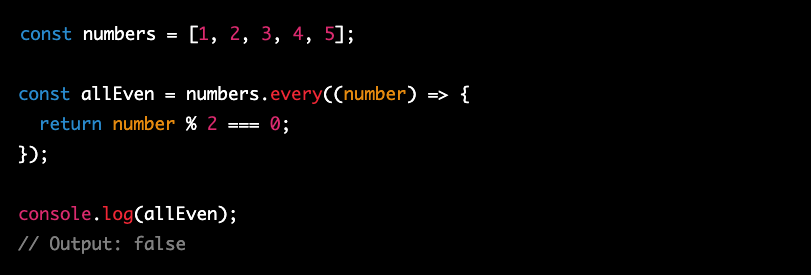
In this example, the every() method is called on the numbers array to check whether all elements in the array are even numbers. The callback function takes one argument number, which is the current element being processed. The callback function returns true if the number is even (i.e., the remainder of dividing number by 2 is 0), and false otherwise. The every() method returns false because not all elements in the array are even.
The every() method can also be used with arrow functions and the thisArg parameter:
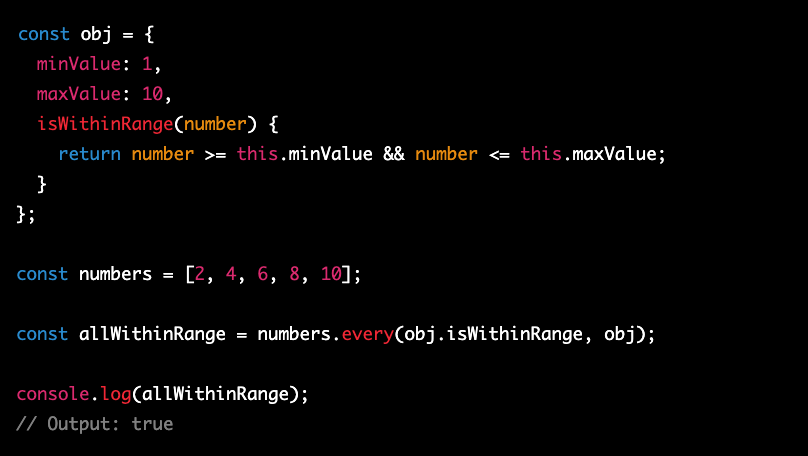
In this example, the every() method is called on the numbers array to check whether all elements in the array are within a certain range. The obj object contains a isWithinRange() method that takes one argument number and returns true if the number is within the range specified by the minValue and maxValue properties of the obj object. The every() method is called with the obj.isWithinRange function and the obj object as the thisArg parameter. The every() method returns true because all elements in the numbers array are within the range specified by the obj object.
The every() method is a powerful tool for testing the contents of an array and determining whether all elements pass a certain condition.
some()
The some() method in JavaScript is a built-in array method that tests whether at least one element in the array passes a certain condition. The some() method returns a Boolean value of true if at least one element in the array passes the condition, and false otherwise.
Here’s the syntax for the some() method:

The array parameter is the array on which to perform the operation. The callback function is the function to execute on each element in the array. The callback function takes three arguments: element (the current element being processed), index (the index of the current element), and array (the array on which the some() method was called). The thisArg parameter is an optional object that can be used as this inside the callback function.
Here’s an example of using the some() method:
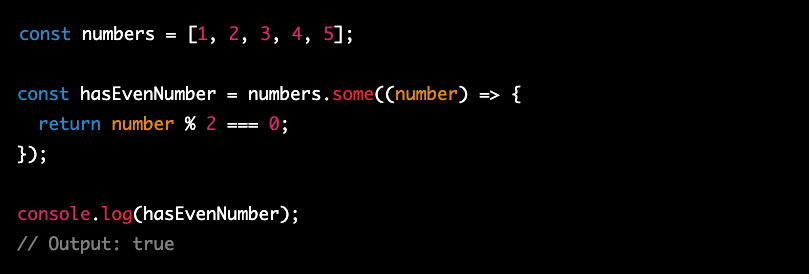
In this example, the some() method is called on the numbers array to check whether there is at least one even number in the array. The callback function takes one argument number, which is the current element being processed. The callback function returns true if the number is even (i.e., the remainder of dividing number by 2 is 0), and false otherwise. The some() method returns true because there is at least one even number in the array.
The some() method can also be used with arrow functions and the thisArg parameter:
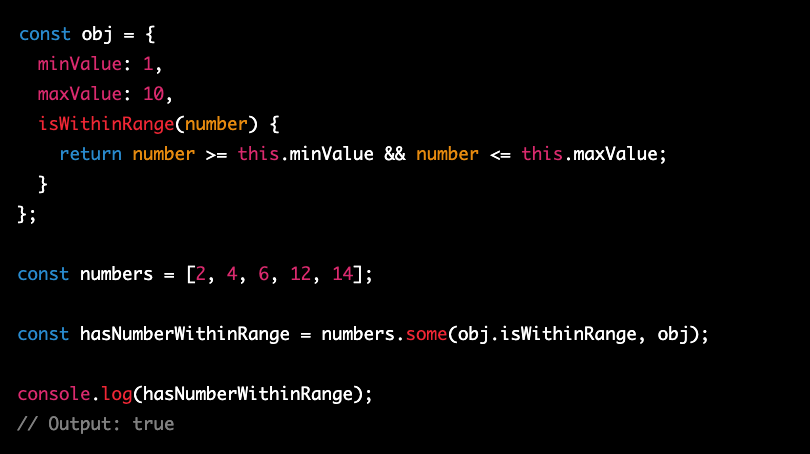
In this example, the some() method is called on the numbers array to check whether there is at least one number in the array that is within a certain range. The obj object contains a isWithinRange() method that takes one argument number and returns true if the number is within the range specified by the minValue and maxValue properties of the obj object. The some() method is called with the obj.isWithinRange function and the obj object as the thisArg parameter. The some() method returns true because there is at least one number in the numbers array that is within the range specified by the obj object.
The some() method is a powerful tool for testing the contents of an array and determining whether at least one element passes a certain condition.
fill()
The fill() method in JavaScript is used to fill the elements of an array with a static value, from a start index (default index 0) to an end index (default index array.length). The method modifies the original array in place and returns the modified array.
The syntax for fill() method is:

- value is the value to fill the array with
- start is the starting index to fill the array (default is 0)
- end is the ending index to fill the array (default is array.length)
Here is an example of using fill() method:

In the first example, the fill() method fills the array arr with the value 0, starting from the index 1 and ending at the index 3. This modifies the original array, and the resulting array becomes [1, 0, 0, 4, 5].
In the second example, a new array arr2 is created with a length of 5 using the new Array() constructor. The fill() method then fills the entire array with the value 0, resulting in the array [0, 0, 0, 0, 0].
copyWithin()
The copyWithin() method in JavaScript is used to copy a sequence of array elements within the same array. It modifies the original array and returns the modified array. The method takes three arguments:
- target: Required. The index to copy the elements to.
- start: Optional. The index to start copying elements from. The default is 0.
- end: Optional. The index to stop copying elements from (excluding this index). The default is the end of the array.
The syntax for copyWithin() method is:

Here is an example of using copyWithin() method:

In the first example, the copyWithin() method copies the elements starting from the index 3 to the end of the array and pastes them into the array starting from the index 1. This modifies the original array, and the resulting array becomes [1, 4, 5, 4, 5].
In the second example, the copyWithin() method copies the elements starting from the index 3 (inclusive) to the index 5 (exclusive) and pastes them into the array starting from the index 1. This modifies the original array, and the resulting array becomes [‘a’, ‘d’, ‘e’, ‘d’, ‘e’, ‘f’].
valueOf()
The valueOf() method in JavaScript returns the primitive value of the specified object. For an array, valueOf() returns the array itself.
The syntax for valueOf() is:

Here is an example of using valueOf():

In this example, we create an array arr with values [1, 2, 3, 4, 5]. Then, we use valueOf() to get the primitive value of the array and store it in a variable arrValue. Finally, we log the arrValue variable to the console, which will output the array [1, 2, 3, 4, 5].
In general, valueOf() is used to get the primitive value of an object, such as an array. However, for an array, it simply returns the array itself, since the array is already a primitive value.
forEach()
The forEach() method in JavaScript is used to execute a provided function once for each element in an array. It is similar to using a for loop to iterate through an array, but with a more concise syntax.
The syntax for forEach() is:

The forEach() method takes a callback function as its argument, which is executed for each element in the array. The callback function can take up to three parameters:
- currentValue: The value of the current element being processed.
- index: The index of the current element being processed.
- array: The array that forEach() is being applied to.
Here is an example of using forEach():

In this example, we create an array arr with values [1, 2, 3, 4, 5]. We use forEach() to iterate through the array and log each element to the console along with its index. The callback function takes two parameters, element and index, and logs a message for each element in the array.
The output of this code would be:

The forEach() method is commonly used for array iteration and can be a useful alternative to a traditional for loop. However, it cannot be used to stop or break out of the loop early, and it does not create a new array or modify the original array.
map()
The map() method in JavaScript is used to create a new array with the results of calling a provided function on every element in the original array. It creates a new array by iterating through the elements of an existing array, applying a transformation function to each element, and returning a new array with the transformed values.
The syntax for map() is:

The map() method takes a callback function as its argument, which is executed for each element in the array. The callback function can take up to three parameters:
- currentValue: The value of the current element being processed.
- index: The index of the current element being processed.
- array: The array that map() is being applied to.
Here is an example of using map():

In this example, we create an array arr with values [1, 2, 3, 4, 5]. We use map() to iterate through the array and square each element. The callback function takes one parameter, element, and returns the square of the element. The map() method then returns a new array with the squared values.
The output of this code would be:

The map() method is commonly used for transforming data in an array and creating a new array with the transformed values. It is a useful alternative to using a for loop with an empty array to push transformed values into a new array.
filter()
The filter() method in JavaScript creates a new array with all elements that pass the test implemented by the provided function. It returns a new array containing only the elements for which the callback function returns true.
The syntax for filter() is:

The filter() method takes a callback function as its argument, which is executed for each element in the array. The callback function can take up to three parameters:
- currentValue: The value of the current element being processed.
- index: The index of the current element being processed.
- array: The array that filter() is being applied to.
Here is an example of using filter():

In this example, we create an array arr with values [1, 2, 3, 4, 5]. We use filter() to iterate through the array and return only the even numbers. The callback function takes one parameter, element, and returns a boolean value indicating whether the element is even or not. The filter() method then returns a new array with only the even values.
The output of this code would be:

The filter() method is commonly used for filtering data in an array based on a condition and creating a new array with the filtered values. It is a useful alternative to using a for loop with an empty array to push filtered values into a new array.
reduce()
The reduce() method in JavaScript executes a callback function on each element of an array and returns a single value. It takes two parameters: the callback function and an optional initial value for the accumulator.
The syntax for reduce() is:

The reduce() method takes a callback function as its first argument. The callback function takes up to four parameters:
- accumulator: The accumulated value previously returned by the callback function, or the initialValue (if provided).
- currentValue: The value of the current element being processed.
- index: The index of the current element being processed.
- array: The array that reduce() is being applied to.
Here is an example of using reduce():

In this example, we create an array arr with values [1, 2, 3, 4, 5]. We use reduce() to iterate through the array and calculate the sum of all the values. The callback function takes two parameters, accumulator and currentValue, and returns the sum of those two values. The reduce() method then returns the final accumulated value.
The output of this code would be:

The reduce() method is commonly used for performing operations that require iterating over an array and accumulating a single result value. It can be used for a variety of tasks, such as calculating the average of an array of numbers or finding the maximum or minimum value in an array.
reduceRight()
The reduceRight() method in JavaScript works similar to the reduce() method, but it starts from the end of the array and moves towards the beginning. It executes a callback function on each element of an array from right to left and returns a single value. It takes two parameters: the callback function and an optional initial value for the accumulator.
The syntax for reduceRight() is:

The reduceRight() method takes a callback function as its first argument. The callback function takes up to four parameters:
- accumulator: The accumulated value previously returned by the callback function, or the initialValue (if provided).
- currentValue: The value of the current element being processed.
- index: The index of the current element being processed.
- array: The array that reduceRight() is being applied to.
Here is an example of using reduceRight():
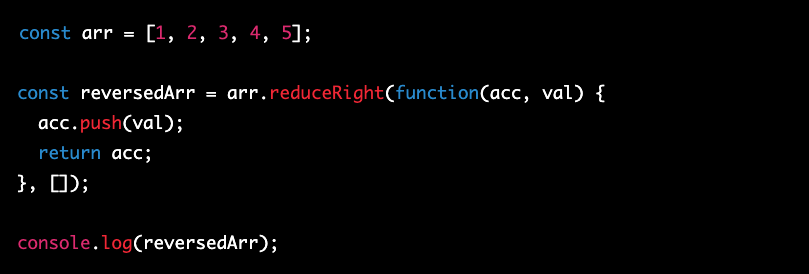
In this example, we create an array arr with values [1, 2, 3, 4, 5]. We use reduceRight() to iterate through the array from right to left and create a new array with the same elements in reverse order. The callback function takes two parameters, accumulator and currentValue, and pushes each currentValue into the accumulator. The reduceRight() method then returns the final accumulated value.
The output of this code would be:

The reduceRight() method is commonly used when the order of the elements in the array matters and the processing of the array needs to start from the end. It can be used for a variety of tasks, such as concatenating strings in reverse order or performing calculations that require iterating over an array from right to left.
from()
The from() method in JavaScript is used to create a new array from an iterable object or array-like object. It returns a new array with the elements of the iterable object or array-like object passed as the first argument. The from() method can also take an optional second argument, which is a map function that can be used to modify the elements of the new array.
The syntax for the from() method is:

- iterable: An iterable object or array-like object to convert to an array.
- mapFunction (optional): A function that is called for each element in the new array, which can be used to transform the elements.
Here is an example of using from() to create an array from an iterable object:

In this example, we create a new Set object mySet with the values [1, 2, 3, 4]. We then use the from() method to create a new array myArr with the same elements as mySet. The from() method takes the mySet object as its first argument and returns an array with the same elements.
Here is an example of using from() with a map function to create a new array with modified elements:

In this example, we create an array myArr with the values [1, 2, 3, 4]. We then use the from() method to create a new array myNewArr with the same elements, but each element multiplied by 2. The second argument to from() is a map function that takes each element of myArr and multiplies it by 2, which results in a new array with the values [2, 4, 6, 8].
The from() method is useful for converting iterable or array-like objects to arrays, which can then be used with other array methods. It can also be used to create new arrays with modified elements, using a map function.
Conclusion:
JavaScript arrays are a fundamental data structure in the language, and they come with a wide range of methods that allow developers to manipulate and analyze arrays efficiently. The methods allow you to add, remove, or modify elements within an array. You can also combine arrays, search for elements, and perform complex operations on arrays.




